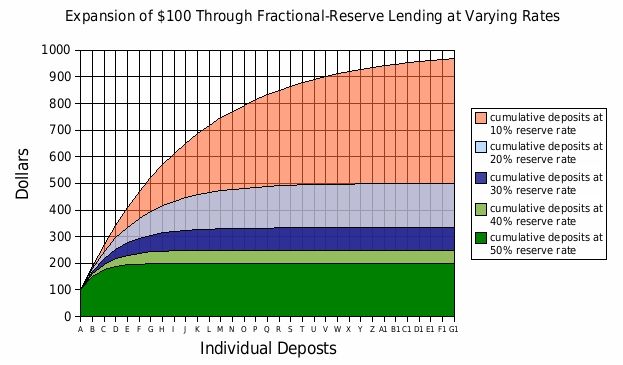|
CRASH 2008-09 -- first wave |
|
10 to 1, the Credit Expansion
10 for 1 credit expansion The current conditions gradual developed through the expansion of currency
(printing money and distributing it through the Federal Reserve Bank system to their member banks and to brokerage houses). Member banks receive $10 for each $1 held in reserve. Thus suppose the Great Pyramid gets a million in deposit more
than withdrawals each month, and it is held in reserve in their vault (or it can be deposited with the San Francisco Federal
Reserve Bank). The Federal Reserve the wires the Pyramid bank $10 million in
funds as a line of credit which it then loans out. Now suppose each month the
Pyramid Bank receives $80,000 as interest on the $10 million loaned out after deducting expense related to the loans. With that $80,000 each month the Pyramid Bank goes to the Feds and borrows another
$800,000. Take a look at the chart on above and you see the pyramid keeps expanding. Flushed with funds various ways of distributing these funds as loans (with
interest charged) were developed. Principle ways including credit cards, home
equity loans, and though the reduction in requirements for business and residential loans.
In order to facilitate the flow of funds the Federal Reserved lowered interest rates, thereby making loans through
the member banks more affordable. Thus for example a bank could make loans to
credit card holders and receive 15% or more per year on funds that cost them less than 3% per year. Moreover the $1 million in liquid deposits put aside entailed that they receive $10 million for to loan
out. Thus on the original $1 million in deposits there is a return of $1.5 million
per year—or more. With housing the banks would bundle mortgages and sell
them, thus with the funds received they could go back to the Feds and borrow more money.
These methods of expansion of and distribution of currency are practiced
around the world.
Two Critics: Ralph Nader, Inflation
and the Federal Reserve (1999): And here he is (Alan Greenspan), widely known as a fierce watchdog against inflationary
trends, yet he is remarkably selective in what kind of inflation he is against. For example, he now recognizes stock values
along with housing values as mainstays of our economy. The prices of stocks have risen vastly more than the prices of housing
over the past six years. Yet apart from some vague mumblings, he seems to be viewing prices of stocks as outside the realm
of an inflationary trend. Other numbers are also going up but they are clearly outside the conventional definitions. Corporate
welfare disbursements and preferences [tax breaks] are proliferating in every direction at all three levels of government,
totalling hundreds of billions of dollars a year. The percentage of the working poor that is under the poverty level is at
a record high...More families are making less in inflation-adjusted income than families did in 1970...Nor is he above inflating
one indicator -- interest rates -- in order to deflate other parts of the economy -- a maneuver that doesn't affect large
corporations as it does consumers and small businesses. The Fed Chairman does show consistent concern about one inflationary
indicator -- any rise in ordinary wages -- and he is regularly relieved to see that they have been "stable," even though labor's
productivity has been up sharply recently. It is clear that he loses little sleep over workers not sharing in the massive
profits that their companies are reaping. |
|
|
A solution: The problem is that by having the wolf run
the hen house, the wolf serves its own interests first. In the immediate case
bankers run the Federal Reserve System with minimal oversight that has become significantly less as the neoliberal ideology
has gained ever greater control of government policy. They argue for the removal
of all controls of the banking system, except for bailing them out.
Is the system needed? In a series of article there is set out fundamental
problems with the Don’t miss the collection of Pod Cast links Nothing
I have seen is better at explaining in a balanced way the development of the national-banking system (Federal Reserve, Bank
of England and others). Its quality research and pictures used to support its
concise explanation set a standard for documentaries--at http://www.freedocumentaries.org/film.php?id=214. The 2nd greatest item in the
|
